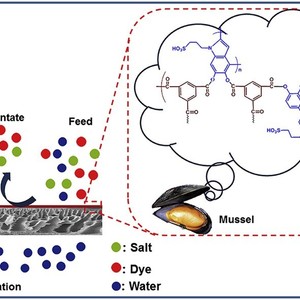Development of Nanofiltration Membranes Using Mussel-Inspired Sulfonated Dopamine for Interfacial Polymerization
Citation
Jincheng Ding, Huiqing Wu*, and Peiyi Wu*. Development of Nanofiltration Membranes Using Mussel-Inspired Sulfonated Dopamine for Interfacial Polymerization. J. Membr. Sci. 2020, 598, 117658.
Abstract
A mussel-inspired sulfonated dopamine (SDA) was synthesized and used as an aqueous monomer to cross-link with trimesoyl chloride (TMC) via interfacial polymerization to prepare nanofiltration membranes. The sulfonic acid groups of SDA were credited with the enhancement of membrane performance, as a result of restraining the process of interfacial polymerization and oxidative-polymerization. Moreover, it also endowed these nanofiltration membranes with more hydrophilic, negatively-charged and smoother surfaces. The optimized nanofiltration membranes (NF-SDA-0.1) exhibited a water flux as high as 62.2 L∙m−2∙h−1 (0.6 MPa), while maintained applicable salt rejection of Na2SO4 (~90.0%) and dye rejections of Congo red, Methyl blue, Methylene blue and Brilliant green (all >99.9%). Thus, the sulfonated dopamine was considered as a promising candidate as aqueous phase monomer for the preparation of high-performance nanofiltration membranes.


